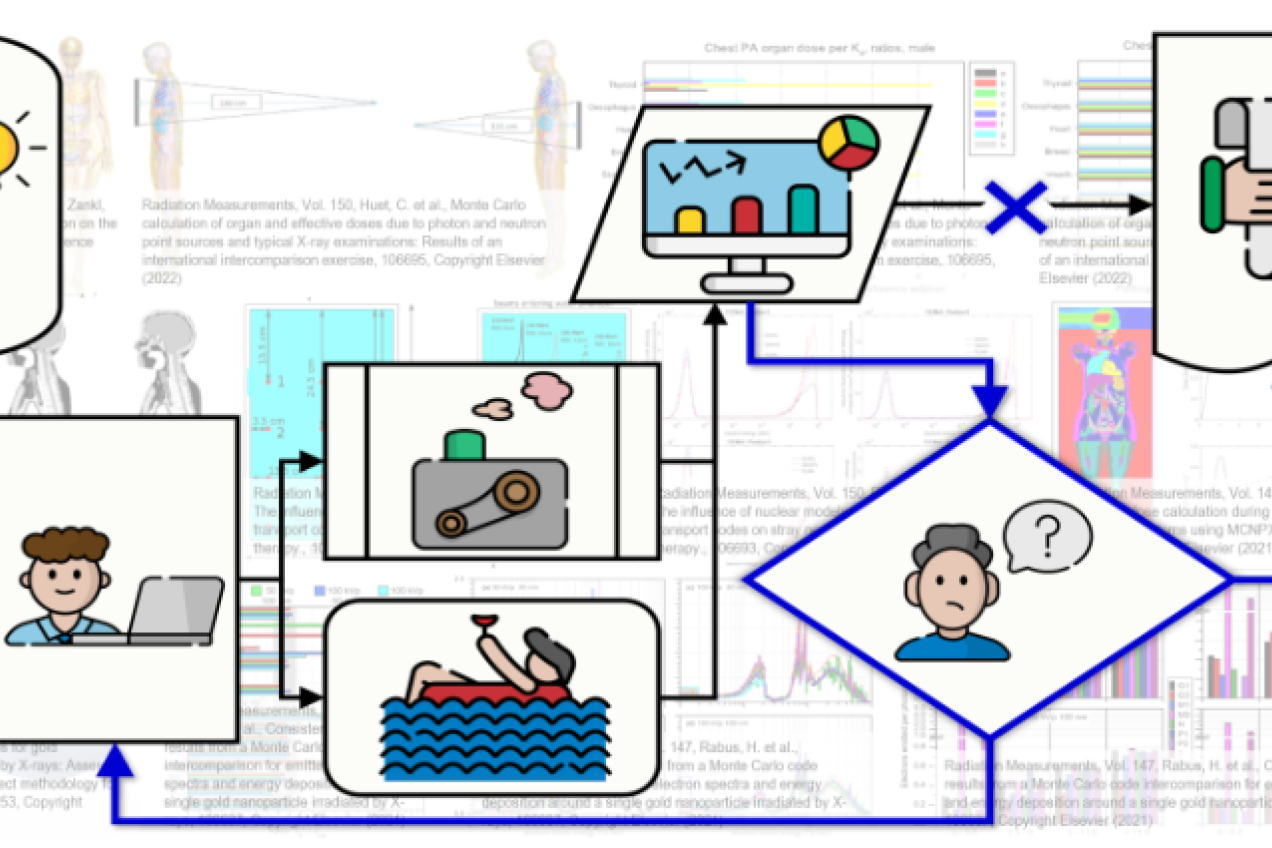18th EURADOS Webinar: Things to consider when your simulations are finished – teasers from "EURADOS WG6 Intercomparisons in Computational Dosimetry" (Special Issue of Radiation Measurements)
All information
Online event
Starting time: 14:00 CET
Overview
Monte Carlo simulations of radiation transport have become an indispensable tool in radiation dosimetry, and many of the available codes have been developed for easy deployment by non-expert users. To monitor the state of the art of the practical use of these tools, several different exercises were organized by EURADOS Working Group 6 “Computational Dosimetry”. The outcomes of these studies have been recently published in a Virtual Special Issue of Radiation Measurements entitled “EURADOS Intercomparison in Computational Dosimetry”.
The webinar presents some of the lessons learned from the exercises regarding common pitfalls and necessary quality checks that researchers performing simulations should be aware of. The examples chosen include a common problem of relevance to medical physics experts (determination of the dose to patient in an X-ray examination), the calculation of the dose to the foetus from proton therapy in pregnancy, and the more academic case of the dose around a single gold nanoparticle in water irradiated by X-rays. The issues considered are not specific to these examples but generalize to all Monte Carlo simulations.
Programme
- 14:00 Welcome and introduction (H. Rabus)
- 14:05 Exercises related to the ICRP/ICRU Adult Reference Computational Phantoms (M. Zankl)
- 14:20 Investigations into the dose to foetus under maternal proton therapy (H. Brkic)
- 14:35 The WG6/WG7 gold nanoparticle exercise (H. Rabus)
- 14:50 Discussion (Moderator: J. Eakins)
Organisation
This webinar is organised by EURADOS WG6 "Computational Dosimetry"
Registration info
Register here!
Speakers
Maria Zankl
Maria Zankl graduated in Mathematics from Technical University Munich, Germany, and presently works with the German Federal Office for Radiation Protection. Her professional experience encompasses the simulation of photon transport in matter using Monte Carlo methods, the calculation of organ dose conversion coefficients for occupational, environmental, and medical radiation exposures and the construction of models of the human body for radiation transport calculations. She was the main developer of the HMGU (former GSF) family of voxel phantoms and of the ICRP/ICRU Adult Reference Computational Phantoms and main author of ICRP Publication 110.
Maria was member of ICRU Report Committee “Phantoms and Computational Models in Therapy, Diagnosis and Protection” (ICRU Report 48, 1988 – 1992), corresponding member of Joint ICRP/ICRU Task Group “Conversion Coefficients for use in Radiological Protection against External Radiation” (ICRP Publication 74, ICRU Report 57, 1993 – 1997), member of ICRU Report Committee “Tissue Substitutes, Phantoms and Computational Modelling in Medical Ultrasound” (ICRU Report 61, 1991 – 1998), and Committee Strahlenschutztechnik (Radiation protection technology) of the German Radiation Protection Commission (2003 – 2008 and 2021 – 2022).
Maria has been member of several Task Groups within ICRP Committee 2: Task Group 4 “Dose Calculations (DOCAL)” (2001-2013); Task Group 96 “Computational Phantoms and Radiation Transport” (since 2014), Task Group 103 “Mesh-type Reference Computational Phantoms” (since 2016), Task Group 113 “Reference Organ and Effective Dose Coefficients for Common Diagnostic X-Ray Imaging Examinations” (since 2019).
Hrvoje Brkic
Hrvoje Brkic received a PhD degree in biophysics from the University of Zagreb in 2013. For the past 10 years his research interests have been Monte Carlo simulations of patient and staff dose estimation during medical irradiation. This includes variety of both imaging and therapeutic procedures in medicine such as radiological imaging, brachytherapy, photon radiotherapy, particle therapy. He is actively engaged in EURADOS working groups 6, 9 and12 activities.
Hans Rabus
Hans Rabus obtained a PhD in physics in 1992 at the Freie Universität Berlin before joining PTB, Germany’s National Metrology Institute. Initially working in the field of synchrotron radiation metrology, he took the lead of the new working group “detector-based optical radiometry” in 2000. In 2005 he changed to ionizing radiation metrology, where he headed the department “Fundamentals of Dosimetry” from 2009 to 2020, which pursued research in cross-section measurements, nanodosimetry, track structure simulation and ion microbeam-based radiobiology. Since 2020 he is Senior Scientist for “Simulation and Artificial Intelligence in Medicine” and is coordinating PTB’s programme “Metrology for Artificial Intelligence in Medicine (M4AIM)”.
Hans joined EURADOS 2009 and engaged in WG 6 “Computational Dosimetry” and WG7 “Internal Dosimetry” (until 2015). From 2012-2018 he was leader of the task “Computational Micro- and Nanodosimetry” within WG6 and since 2018 he is chairing WG6.
